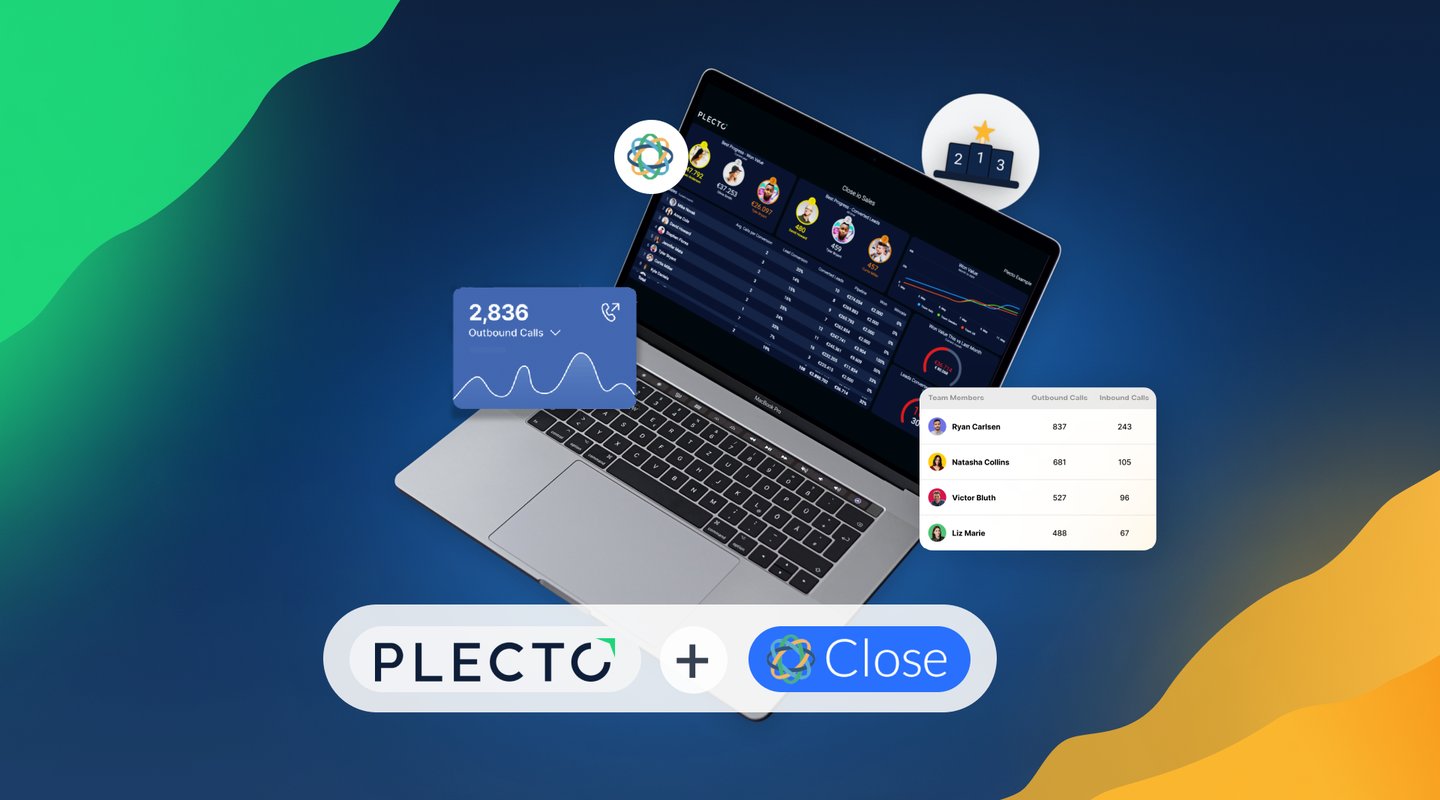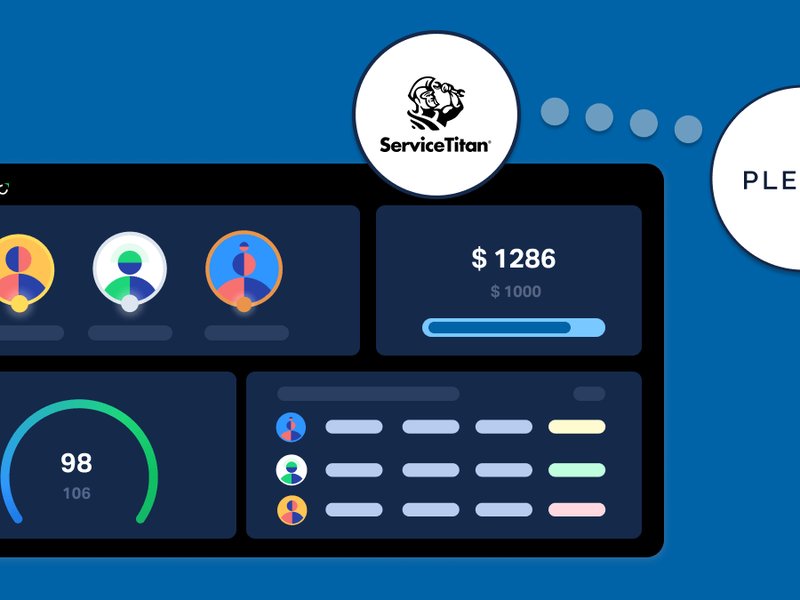Introduction
Close is one of the most popular CRMs for sales teams in SMEs (small and medium enterprises). It’s a highly versatile tool—one that has a Plecto integration to boot, perfect for displaying relevant data on dashboards across your office.
For the sales team that uses Close, especially in conjunction with Plecto, there’s several tried-and-true KPIs that are perfect for tracking in the platform. These KPIs are essential to monitor for any serious and ambitious sales team, and coupled with Plecto’s visualization capabilities, they’ll take your team to the next level. With that, let’s dive in.
1. Number of Waiting Calls
The number of calls made by sales representatives. This can help in understanding the level of outreach efforts.
Also referred to as Calls in Queue, the Number of Waiting Calls indicates how many contacts are trying to reach your team but haven’t yet received a response. While a useful metric, it’s important to dig a little deeper with Calls in Queue, as the raw number can paint widely different pictures depending on the situation.
In other words, the same Number of Waiting Calls can indicate your team is doing well or poorly—it’s highly context-dependent. While a high Number of Waiting Calls might mean your team is attracting a lot of leads, it could also mean that you lack enough staff to handle calls, or that your customers are dissatisfied and are calling in to complain.
Therefore, be sure to evaluate this KPI alongside others—many of which are listed below—to get a better picture of your call center performance.
2. Average Call Duration
The average length of calls. This can be an indicator of the quality of conversations and engagement with potential customers.
Average Call Duration indicates the mean length of time your agents spend on calls within a specified period. “Duration” here indicates the moment the agent picks up the phone to the moment the call ends. Average Call Duration is frequently measured on a daily basis, thereby giving the most accurate indicator of how quickly calls are being processed.
While of course it’s ideal to decrease your Average Call Duration, a word of caution is in order: prioritizing speed above all else creates diminished service quality. When agents’ mindset is simply to get through calls as fast as possible, this more often than not results in customers’ concerns and questions being inadequately addressed—and their dissatisfaction rises.
So keeping your Average Call Duration low—but no lower than necessary—will allow your customers to stay happy and your team perform at an optimal level.
3. Conversion Rate
The percentage of leads that convert into paying customers. This is a critical metric for assessing the effectiveness of the sales process.
The Sales Conversion Rate is crucial for any team to measure their overall success. It’s the number of won deals in a period divided by the total number of opportunities from the same period.
A good Conversion Rate is the direct result of a company knowing its ICP (ideal customer profile) inside and out: what the ICP is, what motivates it, and what they’re willing to pay.
You can think of Conversion Rate as the opposite of Churn Rate: a high Conversion Rate means your Churn Rate is low. A too-high Churn Rate means you’re not targeting the correct demographic, or aren’t responding to your current one appropriately.
4. Lead Response Time
The average time it takes for sales representatives to follow up with a new lead. Faster response times can lead to higher conversion rates.
Lead Response Time is an incredibly important metric that (strangely!) many teams and companies don’t pay nearly enough attention to. Back in 2011, the Harvard Business Review found that the average Lead Response Time among American firms was a stunning 42 hours. This already-high number has even more significance when the same study found that only 77 percent of companies responded to their leads at all!
Basically, many (if not most) companies are throwing promising leads (and revenue) down metaphorical garbage bin. So the best thing your team can do about the Lead Response Time is to reduce it.
After all, the same study found that companies who responded to their leads within an hour of contact were seven times more likely to retain these leads than those who waited more than an hour.
Build your first dashboard.
Start your 14-day free trial today
5. Average Sales Cycle Length
The average time it takes to close a deal from the first contact. A shorter sales cycle can indicate a more efficient sales process.
Just as a product has a life cycle, so too does the sales process. This is called the Average Sales Cycle Length, and it consists of the following stages:
- Finding leads
- Responding to leads
- Qualifying leads
- Presenting the product
- Negotiation and closing
- Maintaining the customer relationship
One of the biggest factors that influences your Average Sales Cycle Length is the type of product you offer and how expensive it is. Firms—especially large ones—that sell expensive or bespoke products will naturally tailor their customer fit more precisely, resulting in a longer time to close and therefore a longer sales cycle. Knowing your Average Sales Cycle Length is key to optimizing your sales strategy on a long-term basis.
6. Customer Acquisition Cost (CAC)
The total cost of acquiring a new customer, including all marketing and sales expenses. This helps in understanding the efficiency of sales and marketing spend.
How much is a single new customer worth? This is the question that Customer Acquisition Cost, or CAC, answers. CAC is found by adding all relevant expenses across sales and marketing in a given period, and dividing by the total number of customers obtained within that period.
Basically, CAC measures a ROI (return on investment) for obtaining new customers: if you invest X amount into sales and marketing, you’ll obtain one new customer. Knowing your ICP and how to target it will prove essential in keeping your CAC costs low and your acquisition process as efficient as possible.
7. Weighted Pipeline Value
How quickly leads move through the sales pipeline. This can help in forecasting revenue and identifying bottlenecks in the sales process.
The Weighted Pipeline Value identifies the likelihood of your sales progressing to the next stage of the sales pipeline. For every stage of the sales pipeline, you assign a weight, or probability, of clearing each stage. Multiplied by the value of the deal, you’re able to ascertain how much revenue you’ll likely generate in the near future.
For example, you might assign a 50 percent likelihood of qualifying a lead for a deal worth €10,000, and a 10 percent chance of closing another deal worth €20,000.
- 50% x €10,000 = €5000
- 10% x €20,000 = €2000
You then add these probabilities together to obtain an overall value of the deals in your pipeline—in this case, €7000. The Weighted Pipeline Value possesses a lot of predictive power, so use this metric to determine which leads are worth following—and those that are worth leaving behind!
8. Win Rate
The percentage of deals won out of the total number of opportunities. This can indicate the effectiveness of the sales team in closing deals.
Finally, the Sales Win Rate, also called the Win Rate of Deals, indicates the percentage of sales generated from opportunities/prospects over a given period. It’s not surprising that this is one of the most crucial metrics for both your sales team and C-suite to keep track of.
The best way to increase your Win Rate is to be more selective in your lead qualification process, as well as to closely analyze your performance to account for any discrepancies or weak points—for example, agents who might require additional coaching and guidance.
Conclusion
Using Plecto’s Real-time or Dynamic Dashboards alongside your Close CRM setup will allow you a huge degree of flexibility and customization of your sales data. Measuring and tracking these KPIs in Close, and then visualizing them on Plecto’s dashboards, will help you obtain more comprehensive insights into your sales process and ability to generate revenue.
If this sounds appealing to you, give Plecto a shot and use it alongside Close. You have a free two-week trial period—and we guarantee you’ll see a difference firsthand!

JAMES NIILER
Content Writer
An in-house content writer and specialist at Plecto, James brings an academic touch and journalistic flair to his marketing copy. Having worked and studied on both sides of the Atlantic, James is a great believer in the importance of communicating across cultures and industries. Catch his work here on the Plecto blog, or as a guest contributor on other B2B websites.



